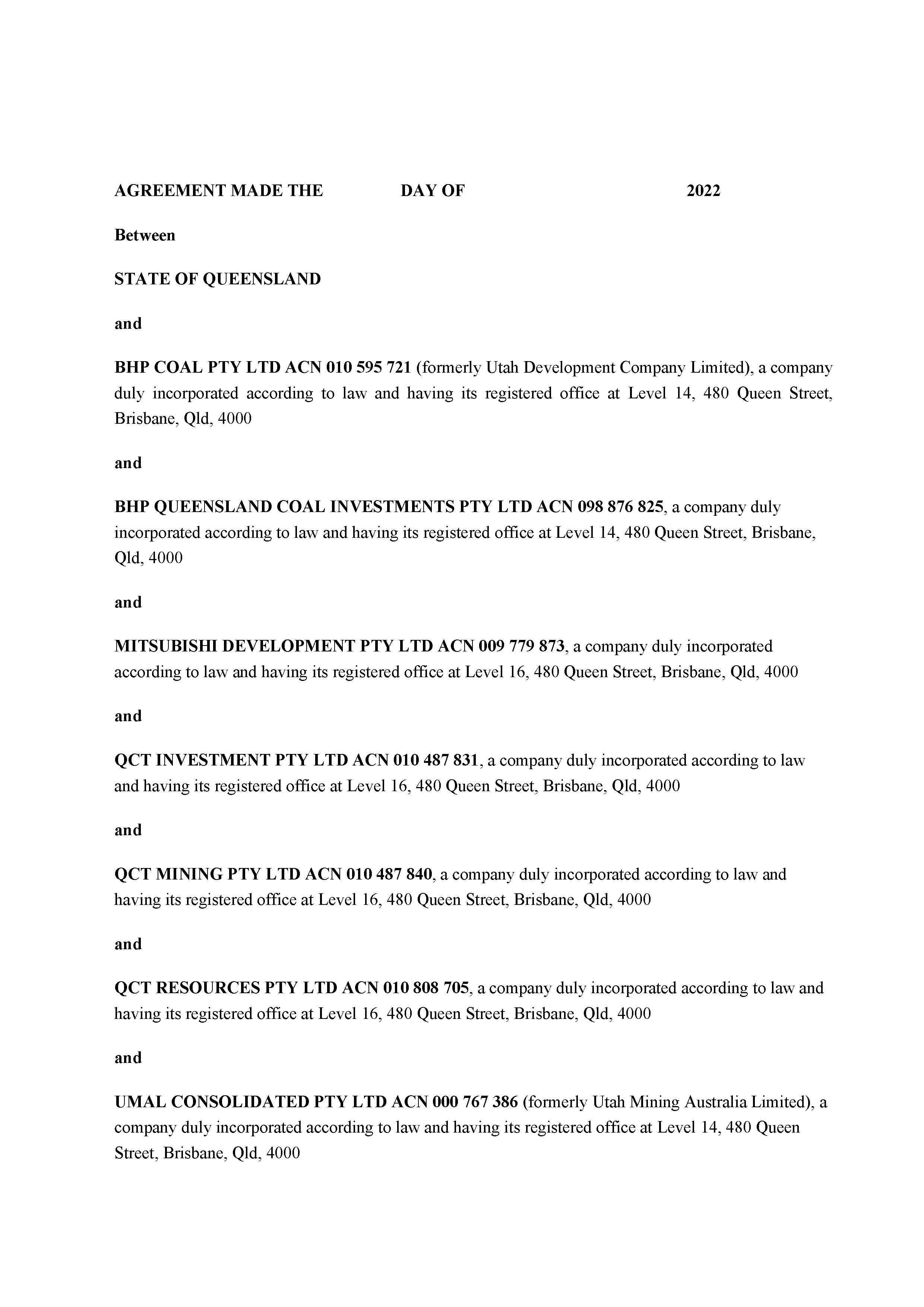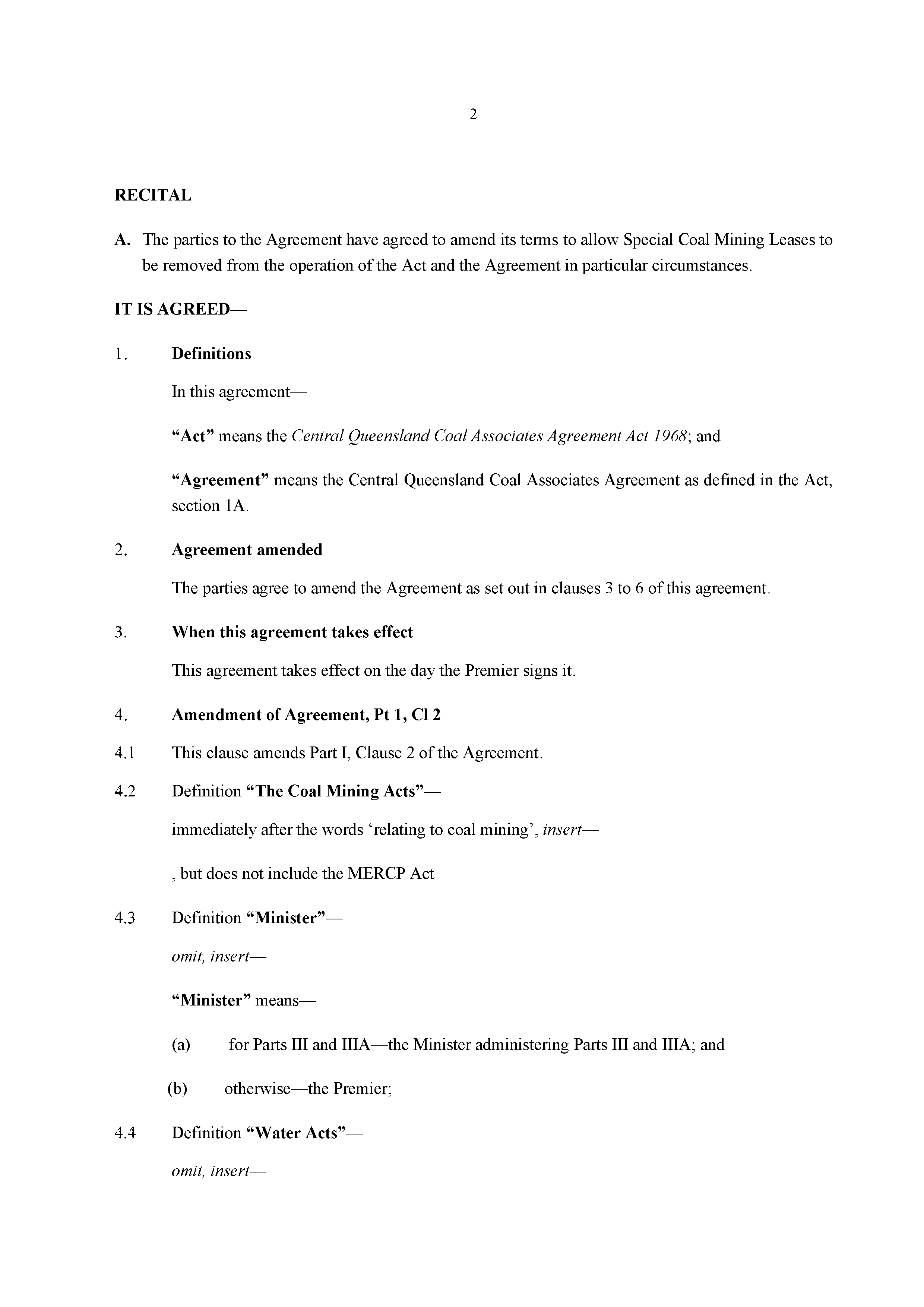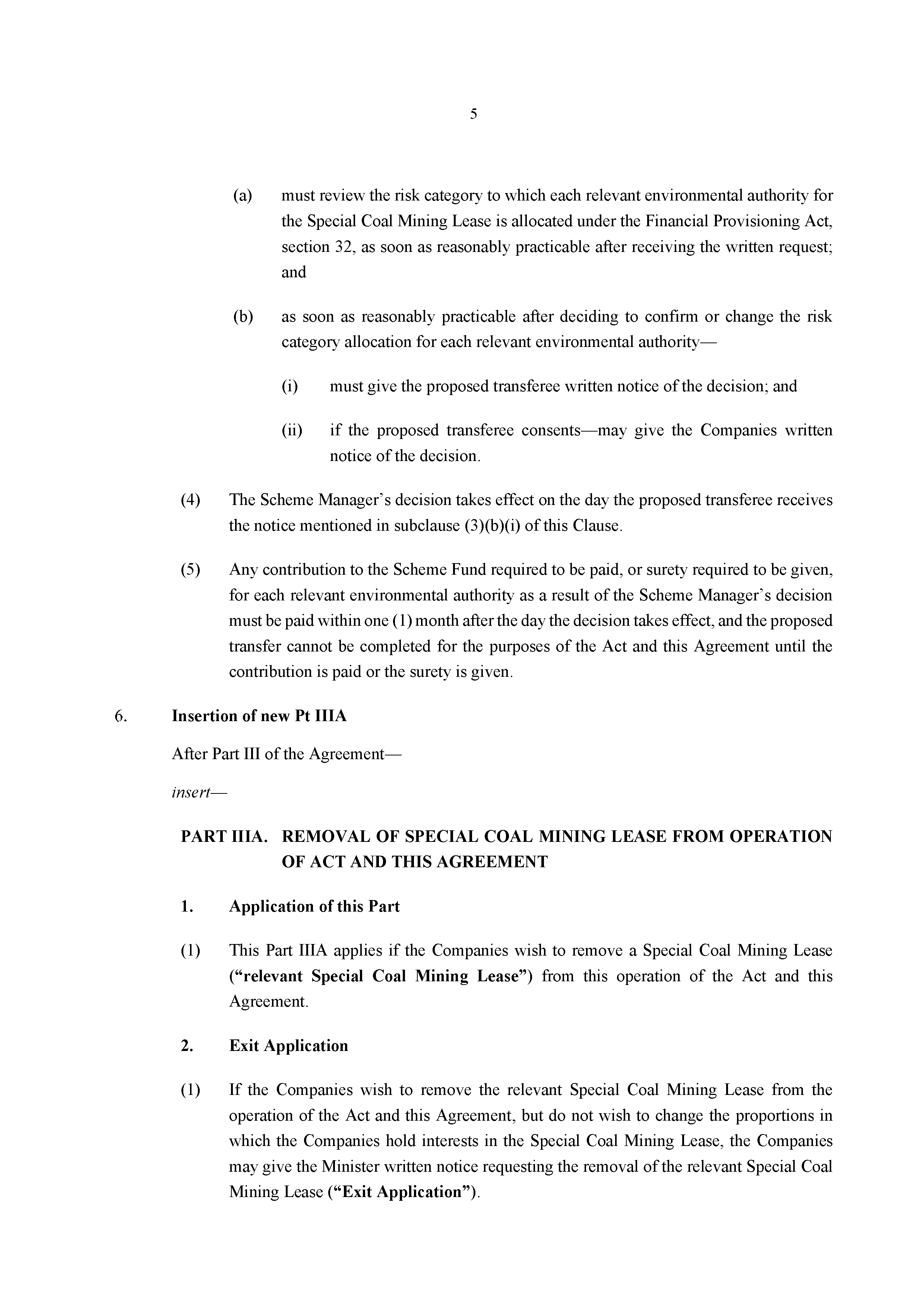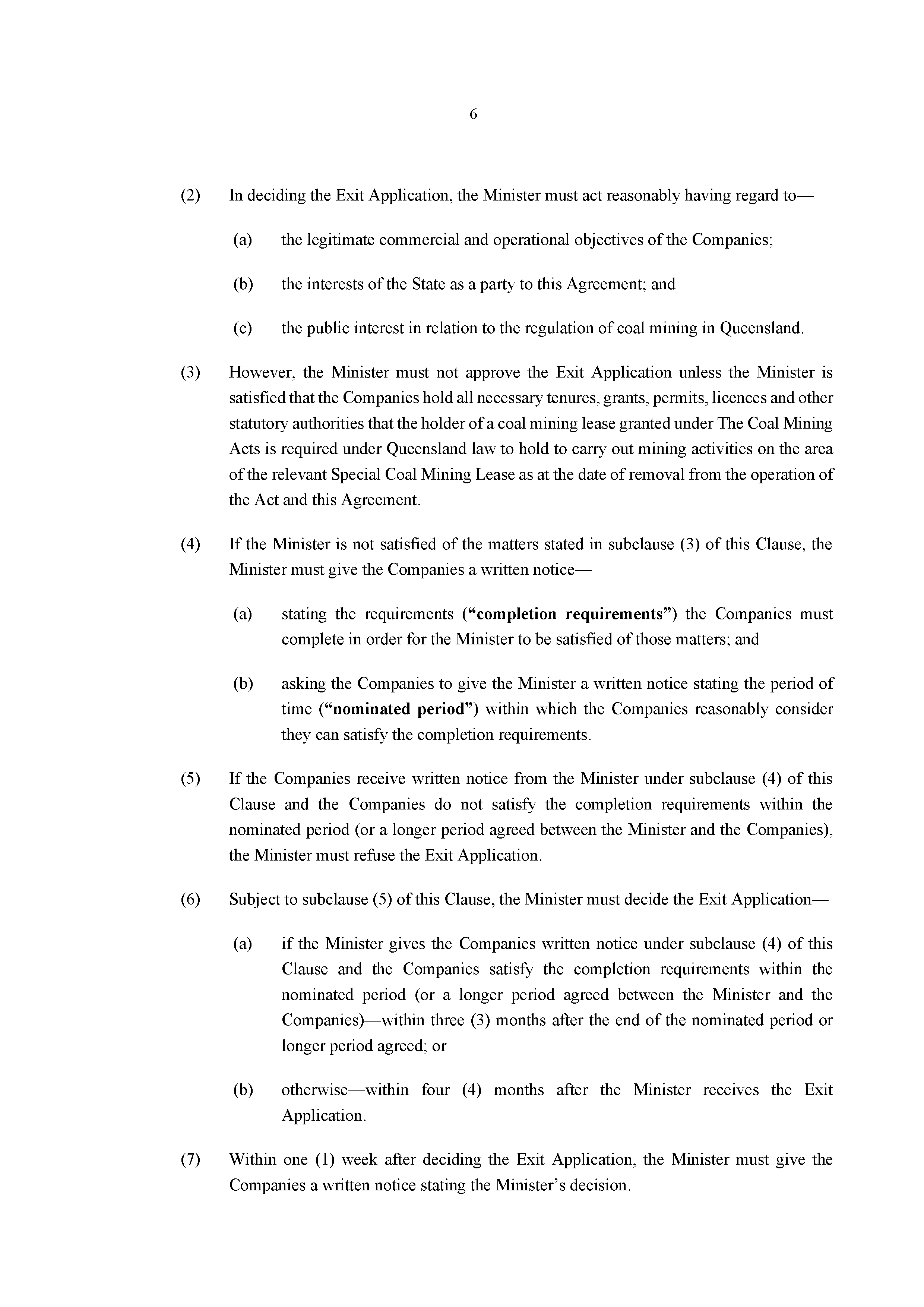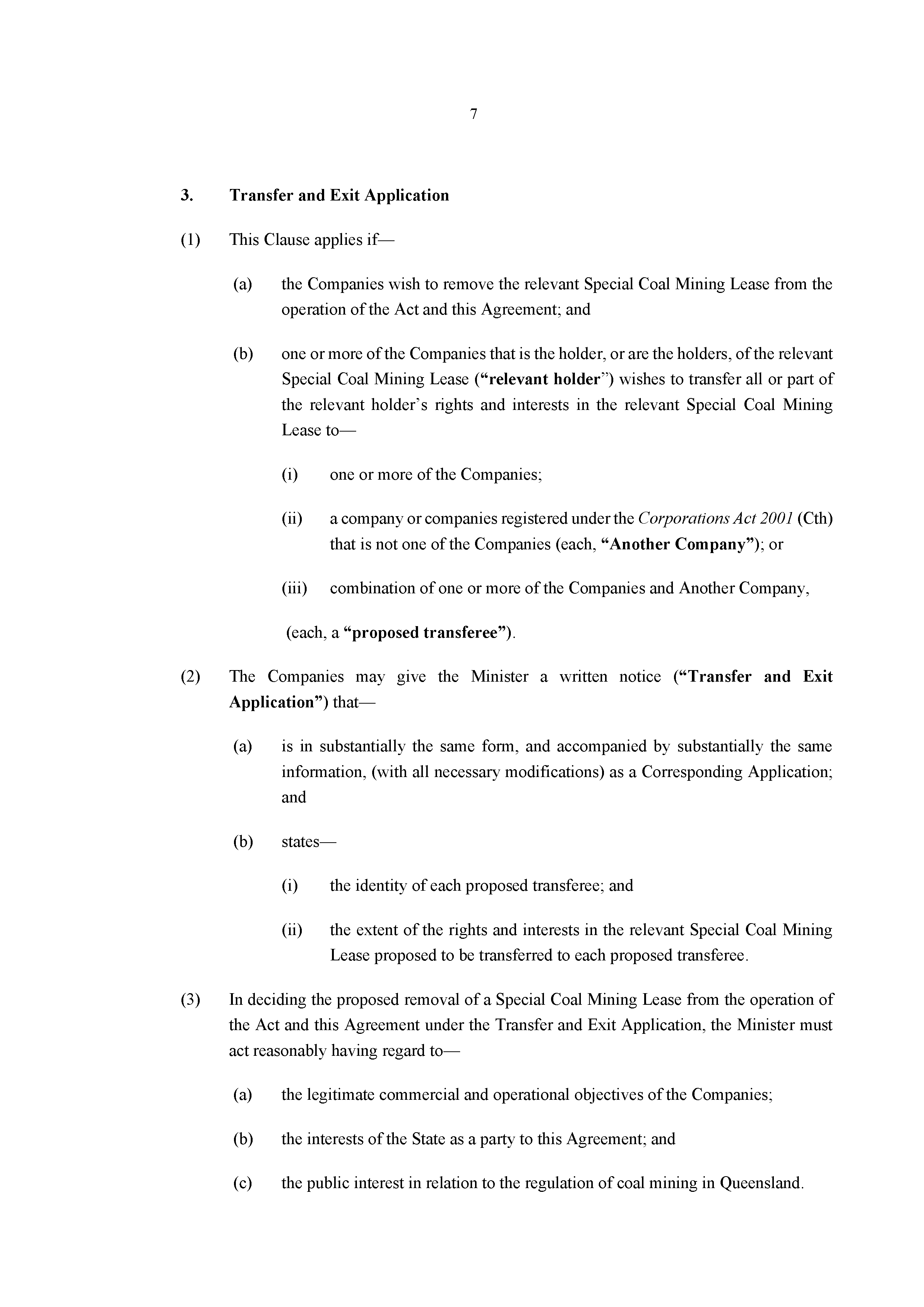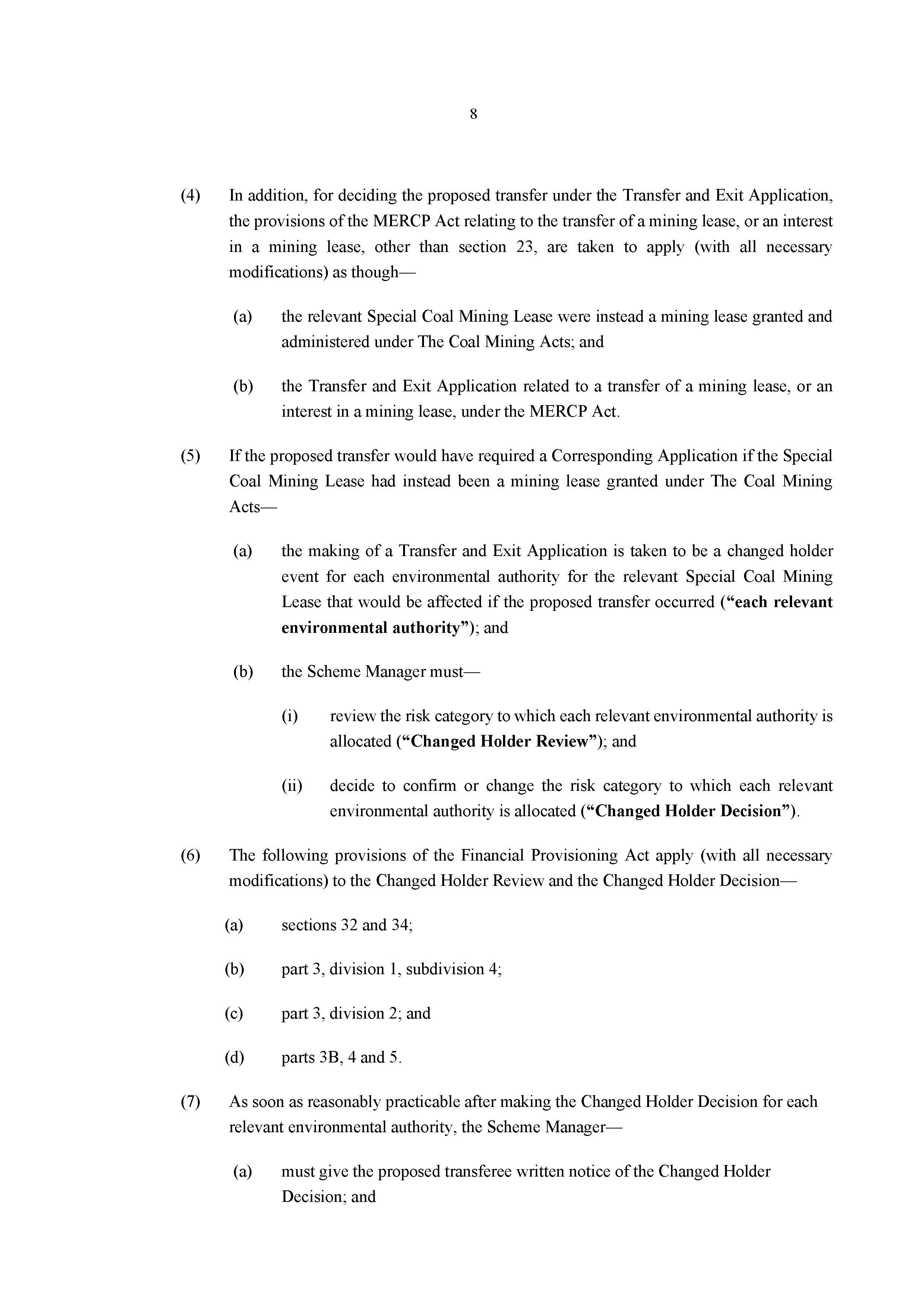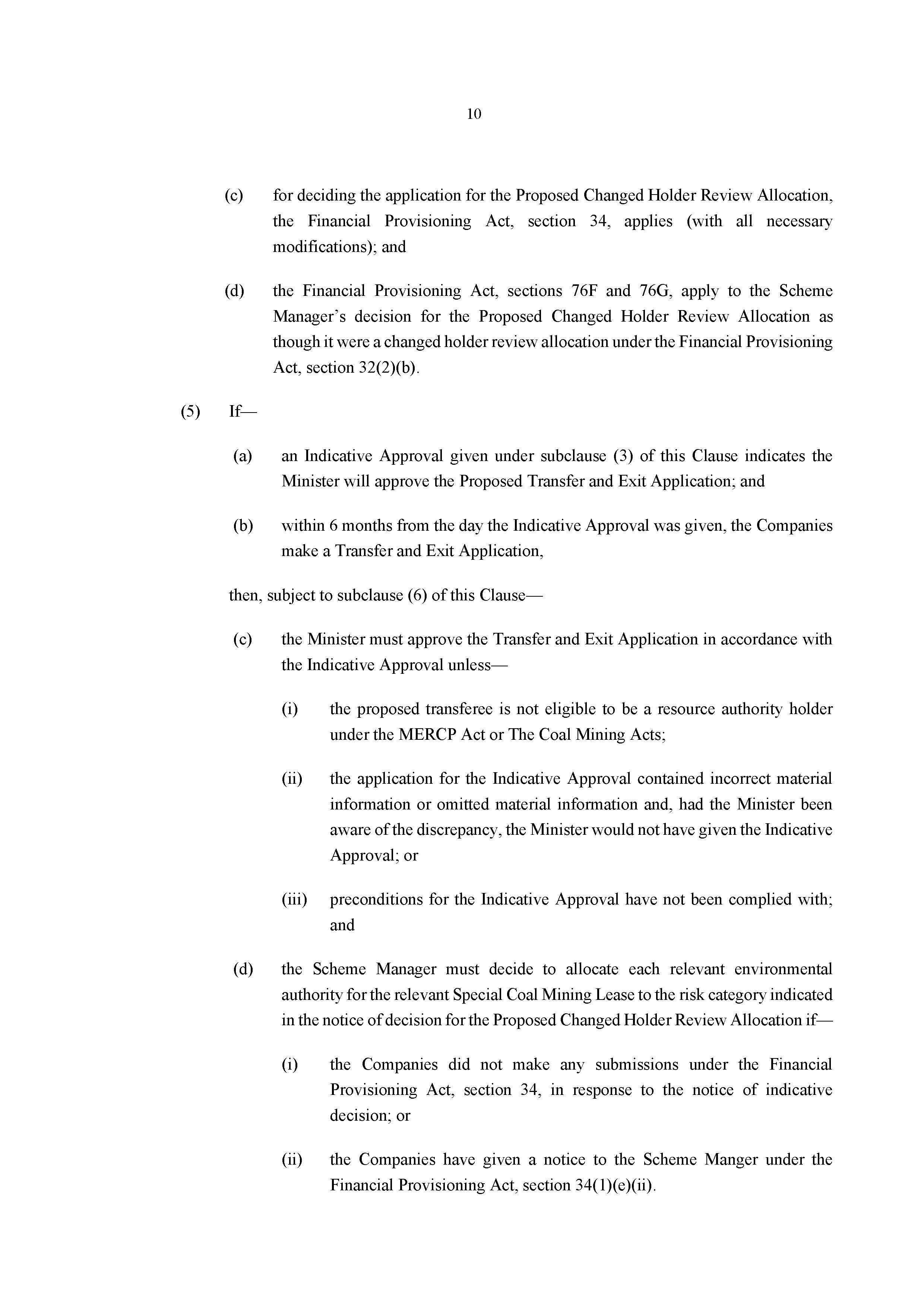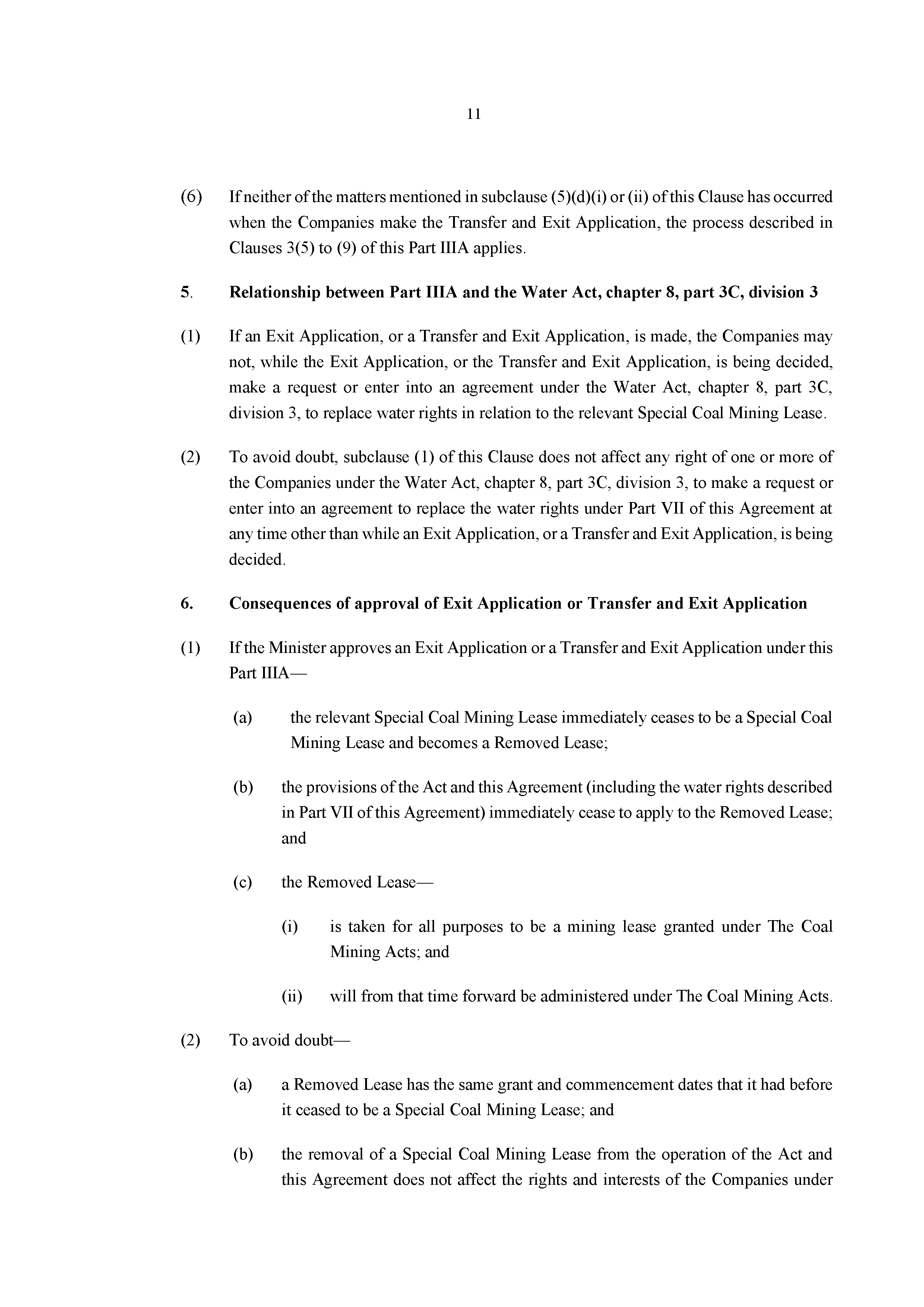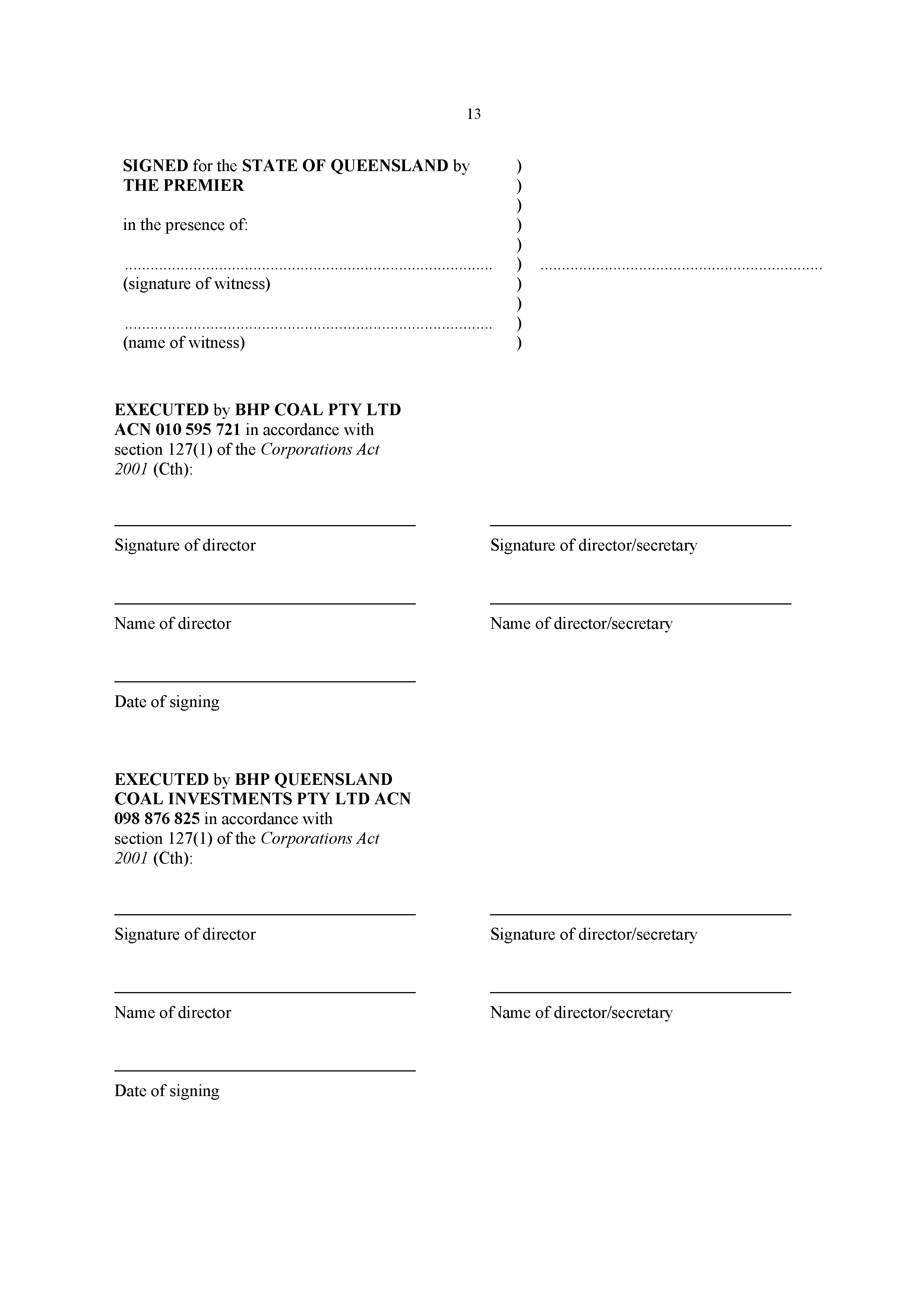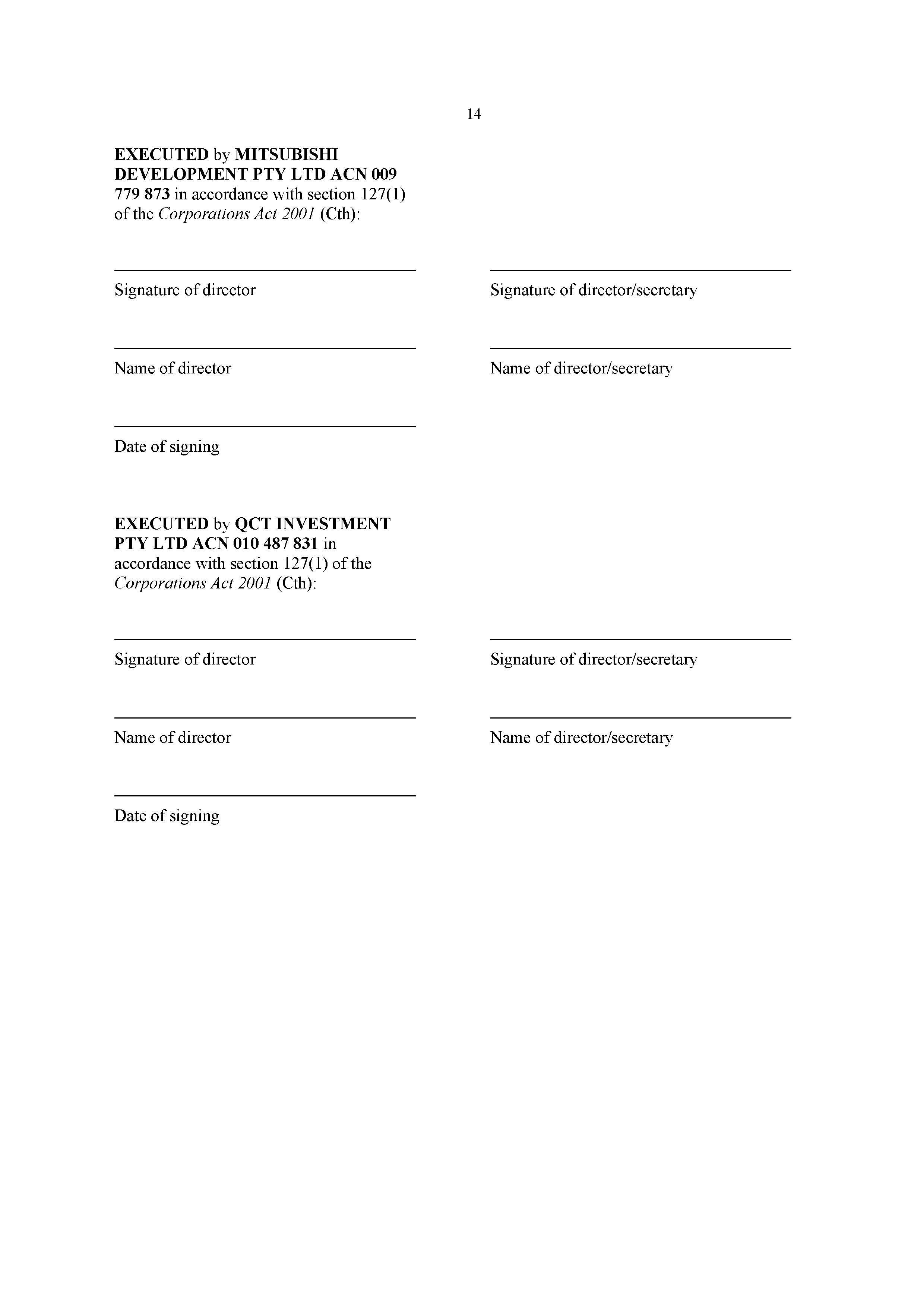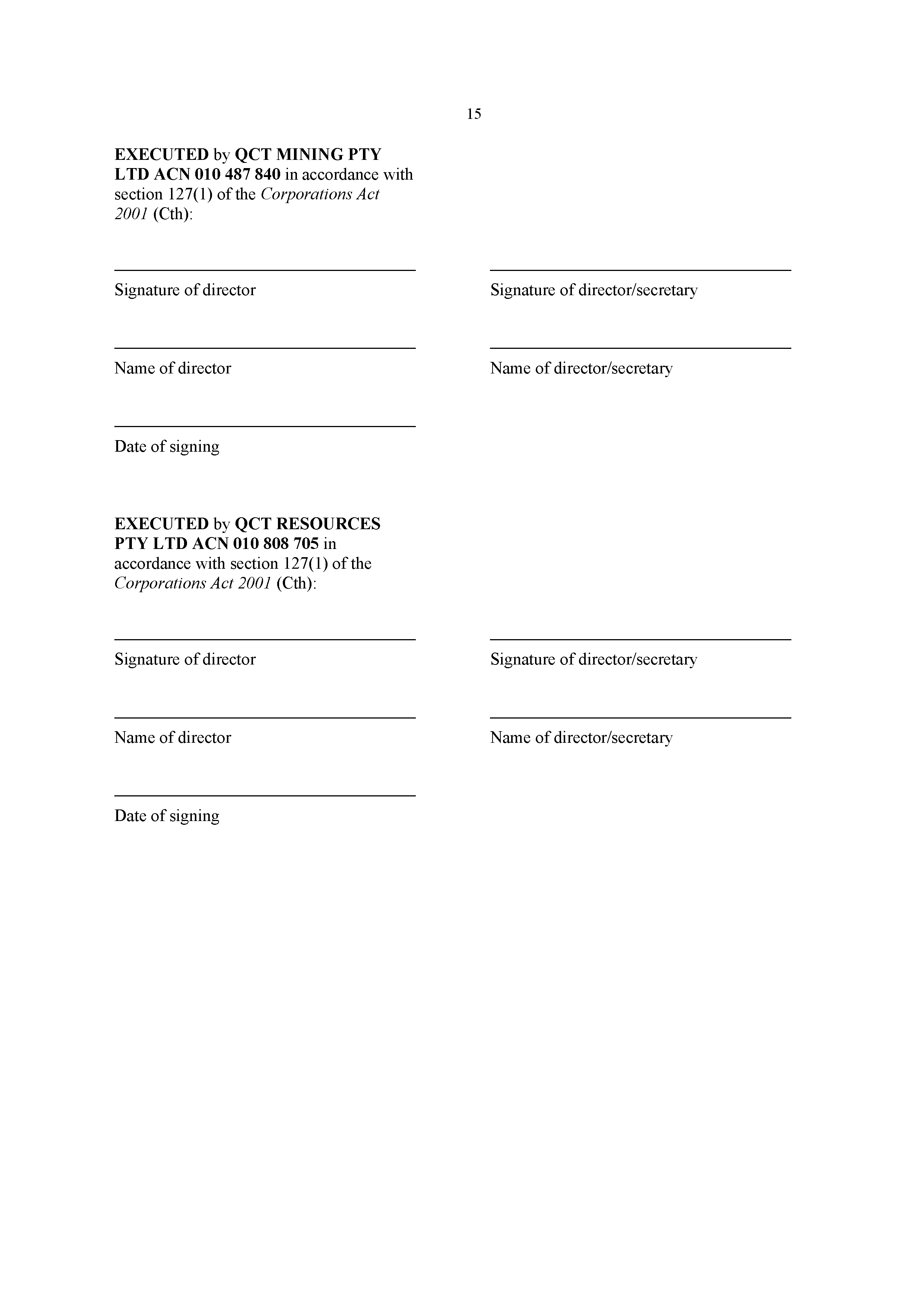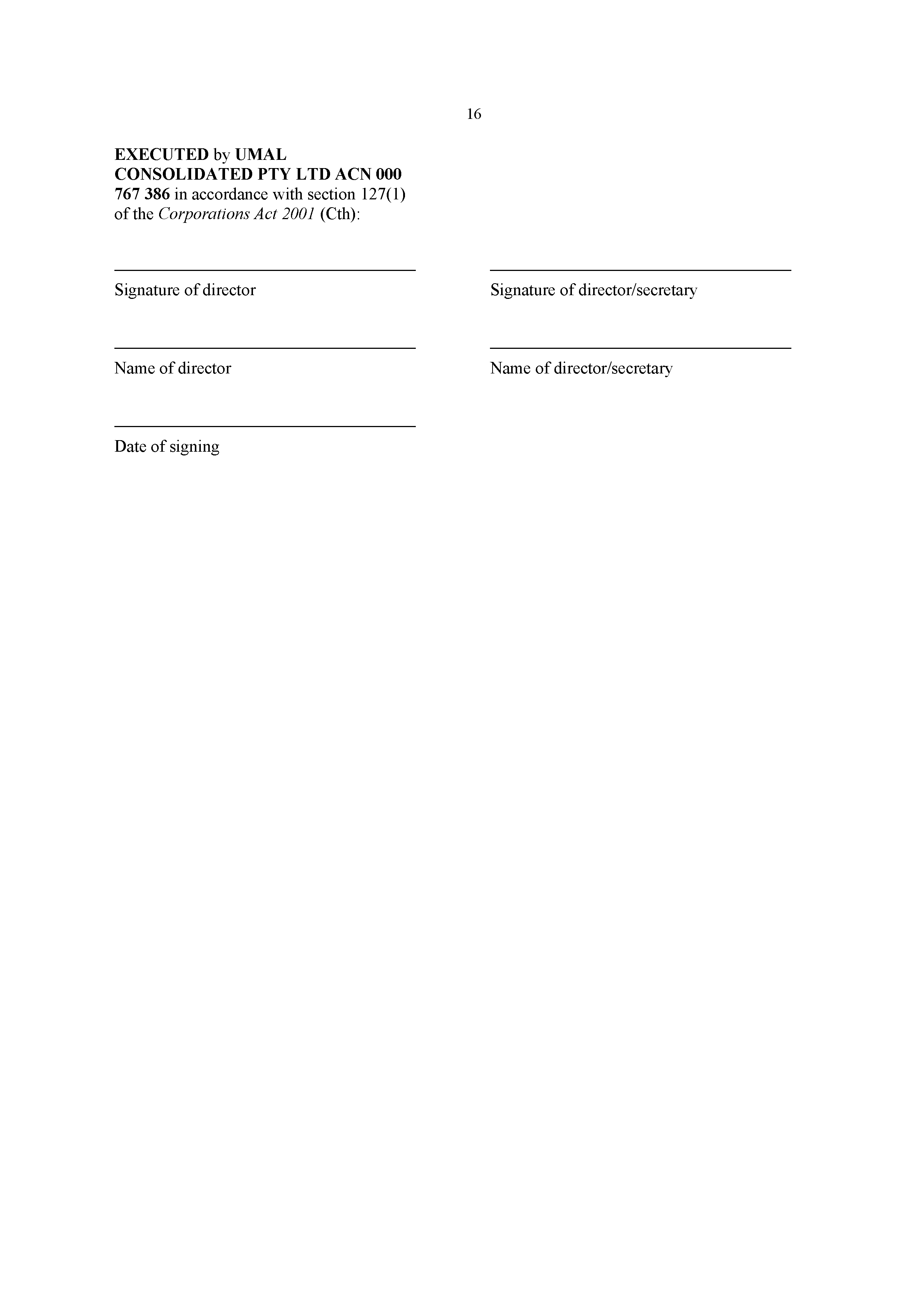An Act to amend the Cape York Peninsula Heritage Act 2007, the Central Queensland Coal Associates Agreement Act 1968, the Land Act 1994, the Land Regulation 2020, the Land Title Act 1994, the Mineral Resources Act 1989, the Place Names Act 1994, the Stock Route Management Act 2002, the Survey and Mapping Infrastructure Act 2003, the Survey and Mapping Infrastructure Regulation 2014, the Vegetation Management Act 1999 and the legislation mentioned in schedule 1 for particular purposes, and to repeal the Foreign Governments (Titles to Land) Act 1948, the Starcke Pastoral Holdings Acquisition Act 1994, the Survey and Mapping Infrastructure (Survey Standards) Notice 2021, the Survey and Mapping Infrastructure (Survey Standards—Requirements for Mining Tenures) Notice (No. 1) 2011 and the Yeppoon Hospital Site Acquisition Act 2006
The Parliament of Queensland enacts—
This Act may be cited as the Land and Other Legislation Amendment Act 2023.
The following provisions of this Act commence on a day to be fixed by proclamation—(a)sections 63(2) and (3), 64 and 65;(b)section 67, to the extent it inserts section 187B(1)(a);(c)section 69, to the extent it inserts section 340;(d)sections 79, 81, 83 and 86;(e)sections 94, 101 to 104, 106 and 107;(f)schedule 1, amendment of Stock Route Management Act 2002, amendment 4.
Part 2 Amendment of Cape York Peninsula Heritage Act 2007
This part amends the Cape York Peninsula Heritage Act 2007.
4Amendment of schedule (Dictionary)
Schedule, definition landholder for the land, paragraph (a), from ‘land trust’ to ‘for’—
omit, insert—trustee, under the Aboriginal Land Act 1991, of
Part 3 Amendment of Central Queensland Coal Associates Agreement Act 1968
This part amends the Central Queensland Coal Associates Agreement Act 1968.
After section 9A—
insert—9BMaking of 2022 agreement authorised
(1)The Premier is authorised, for the State, to make an agreement (the 2022 agreement) with the other parties named in the 2022 agreement.(2)The 2022 agreement must be substantially in the form set out in schedule 7.(3)The Premier must notify, by gazette notice, the date the 2022 agreement is made.
After schedule 6—
insert—section 9B
Part 4 Amendment of Land Act 1994
This part amends the Land Act 1994.See also the amendments in schedule 1.
9Amendment of s 8 (Definitions for pt 4)
Section 8, definition right line tidal boundary, from ‘land that’—
omit, insert—land that—
(a)is located approximately where a tidal boundary might otherwise be located; orThe boundaries of a lot include a tidal boundary. Because of difficulties arising in relation to the location at law of the tidal boundary, or for some other reason, the registered owner of the lot agrees to surrender the lot to the State. The lot is resurveyed, and a new deed of grant is issued for the lot, but without the tidal boundary. The deed of grant and associated plan of survey now provide for a right line boundary in a location that is the approximate location of the previous tidal boundary.(b)adjoins land that is, whether permanently or from time to time, covered by tidal water.
10Amendment of s 9 (Land adjacent to tidal boundary or right line tidal boundary owned by State)
(1)Section 9(6), ‘commencement of this section’—
omit, insert—relevant commencement
(2)Section 9—
insert—(7)For subsection (6), relevant commencement means—(a)in relation to a tidal boundary or right line tidal boundary under section 8, definition right line tidal boundary, paragraph (a)—the commencement of subsection (6); or(b)in relation to a right line tidal boundary under section 8, definition right line tidal boundary, paragraph (b)—the commencement of this subsection.
11Amendment of s 60 (Trustee permits)
(1)Section 60(2)—
omit, insert—(2)A trustee permit must not be inconsistent with—(a)the purpose of the trust land; or(b)the requirements prescribed by regulation.(2A)Despite subsection (2)(a), a trustee permit may be inconsistent with the purpose of the trust land if—(a)a management plan for the trust land has been approved under section 48; and(b)the management plan—(i)identifies the potential impacts of the trustee permit being inconsistent with the purpose of the trust land; and(ii)states how the trustee permit being inconsistent with the purpose of the trust land would not diminish the purpose of the trust land.(2)Section 60(2A) to (4)—
renumber as section 60(3) to (5).
12Amendment of s 70 (Sale by mortgagee in possession)
Section 70(3), from ‘, in’—
omit, insert—that the land is for sale, in a way the mortgagee considers is reasonably likely to come to the attention of members of the public in the locality of the land.
Examples of ways a notice may be published under subsection (3)—
•displaying the notice on the land so the notice is conspicuous and easily visible to members of the public from a place other than the land•publishing the notice in a newspaper circulating generally in the locality of the land•publishing the notice in an online local newspaper for the locality of the land
13Amendment of s 98 (Closure of road)
Section 98(2)—
omit, insert—(2)The Minister may—(a)permanently close the road without receiving an application under section 99(1); or(b)temporarily close the road without receiving an application under section 99(3).
14Amendment of s 130 (Transfer of lease for significant development)
(1)Section 130(1)—
omit, insert—(1)Before a lease issued for a significant development is transferred, the chief executive may obtain an independent assessment of the transferee’s financial and managerial capabilities.(2)Section 130—
insert—(4)If the chief executive obtains an assessment under subsection (1), the lease must not be transferred to the transferee unless the Minister is satisfied, having regard to the assessment, about the transferee’s financial and managerial capabilities.
15Omission of ch 4, pt 1, div 3 (Availability of additional areas)
Chapter 4, part 1, division 3—
omit.
16Amendment of s 156 (Lessee must give improvements report and other information)
(1)Section 156(1), before paragraph (a)—
insert—(aa)the chief executive decides not to make an offer of a new lease under section 157B; or(2)Section 156(1)(b)—
omit, insert—(b)a renewal application made by the lessee is refused.(3)Section 156(1)(aa) to (b)—
renumber as section 156(1)(a) to (c).
After section 157A—
insert—157B Deciding not to make offer of new lease before receiving renewal application
(1)The chief executive may decide not to make an offer of a new lease at any time before receiving a renewal application from the lessee of a term lease.(2)Before deciding not to make an offer of a new lease under subsection (1), the chief executive must—(a)give the lessee a notice stating each of the following—(i)that the chief executive proposes not to make an offer of a new lease;(ii)the reasons for the chief executive’s proposal not to make an offer of a new lease;(iii)that the lessee may, within the reasonable period stated in the notice, make written submissions about any matter relevant to the reasons for the chief executive’s proposal; and(b)consider any written submissions made by the lessee within the period stated in the notice.(3)Sections 420FA, 420G and 420H apply in relation to making a decision under subsection (1)—(a)as if a reference in the sections to deciding or refusing an application were a reference to making the decision; and(b)with other necessary changes.
18Amendment of s 158 (Application for new lease)
(1)Section 158(1), from ‘unless’—
omit, insert—unless—
(a)the chief executive has given the lessee a notice under section 157B(2)(a) and the chief executive is continuing to consider whether to make a decision under that section; or(b)the chief executive has made either of the following decisions on the ground that a new lease is not the most appropriate form of tenure for the lease land—(i)a decision not to make an offer of a new lease under section 157B;(ii)a decision to refuse an earlier renewal application; or(c)a condition of the lease or this Act prohibits the renewal of the lease.(2)Section 158(3)(a) and (b)—
omit, insert—(a)the chief executive has made either of the following decisions other than on the ground that a new lease is not the most appropriate form of tenure for the lease land—(i)a decision not to make an offer of a new lease under section 157B;(ii)a decision to refuse an earlier renewal application; and(b)there is no relevant change in circumstances from the decision under section 157B or the earlier application.
19Amendment of s 159A (Provisions for decision about most appropriate form of tenure)
(1)Section 159A(1), ‘the subject of a renewal application’—
omit.(2)Section 159A(3), after ‘decision’—
insert—in relation to a renewal application
(3)Section 159A(4), ‘the election’—
omit, insert—an election under subsection (3)
20Amendment of s 160 (Notice of chief executive’s decision)
Section 160(2) and (3)—
omit, insert—(2)If the chief executive decides not to make an offer of a new lease under section 157B or decides to refuse a renewal application (each a refusal decision), the lessee must be given notice of the reasons for the refusal decision.(3)The lessee may appeal against the chief executive’s refusal decision if the only reason for the decision was that the lessee had not complied with the conditions of the lease.
21Amendment of s 165A (Chief executive’s approval required for conversion)
Section 165A, from ‘if’—
omit, insert—if the chief executive has made an offer to convert the lease under this division and the offer has been accepted.
After section 165A—
insert—165B Deciding to make offer to convert lease before receiving conversion application
(1)The chief executive may, at any time before receiving a conversion application, decide to offer to convert—(a)a perpetual lease to freehold land; or(b)a term lease to freehold land; or(c)a term lease to a perpetual lease, but only if the term lease is—(i)a lease for pastoral purposes; or(ii)a lease for tourism purposes for land on a regulated island.(2)Before making a decision under subsection (1), the chief executive must evaluate the lease land to assess the most appropriate tenure for the land.(3)For conducting the evaluation under subsection (2), section 16 applies with necessary changes.(4)Sections 420FA and 420G apply in relation to making a decision under subsection (1)—(a)as if a reference in the sections to deciding an application were a reference to making the decision; and(b)with other necessary changes.
23Amendment of s 166 (Application to convert lease)
Section 166(2)(a) and (b)—
omit, insert—(a)either—(i)the lessee has rejected an earlier offer by the chief executive to convert the lease to freehold land or a perpetual lease; or(ii)the lessee has made an earlier conversion application and the application was refused; and(b)there is no relevant change in circumstances from the rejection of the chief executive’s offer or the earlier application.
24Amendment of s 167 (Provisions for deciding application)
(1)Section 167, heading, after ‘deciding’—
insert—conversion
(2)Section 167, before subsection (1)—
insert—(1AA)This section applies in relation to the chief executive deciding a conversion application.(3)Section 167(2), ‘Subsection (1)’—
omit, insert—Subsection (2)
(4)Section 167(2), ‘fulfilment of’—
omit, insert—compliance with
(5)Section 167(3), ‘subsection (1)(d)’—
omit, insert—subsection (2)(d)
(6)Section 167(6), ‘subsection (1)(k)’—
omit, insert—subsection (2)(k)
(7)Section 167(6), ‘in subsection (1)’—
omit, insert—in subsection (2)
(8)Section 167(1AA) to (7)—
renumber as section 167(1) to (8).
25Amendment of s 168 (Notice of chief executive’s decision)
(1)Section 168(1), ‘applicant’—
omit, insert—lessee
(2)Section 168(1A), ‘application’—
omit, insert—offer
(3)Section 168(3)—
omit, insert—(3)The offer may be for—(a)a smaller size area of land; or(b)if the offer is made in relation to a conversion application—a different tenure from the tenure applied for.(4)Section 168(4) and (5), ‘the conversion’—
omit, insert—a conversion
(5)Section 168(5), ‘fulfilled’—
omit, insert—complied with
26Replacement of s 176Z (When payment obligations end if lease ends under part)
Section 176Z—
omit, insert—176Z When payment obligations end if lease ends under part
(1)This section applies if a lease ends under this part.(2)An obligation to pay future rent and other amounts that may become payable in relation to the lease stops on—(a)if the lease ends because an offer to convert the lease to freehold land is accepted—the day the offer to convert the lease is accepted; or(b)otherwise—the day before the day on which the lease ends.
Sections 206 and 207—
omit.
28Amendment of s 247 (Application of payment for improvements by incoming lessee or buyer)
Section 247(2)—
omit, insert—(2)However, no amount is payable by the State to—(a)a person mentioned in subsection (1), if the person waives the person’s entitlement to payment of the amount; or(b)a person who was a registered lessee of a lease, if the lease was forfeited because the lessee acquired the lease by fraud or was not eligible to acquire or hold the lease.
29Amendment of s 322 (Requirements for transfers)
(1)Section 322(2)(a)—
omit, insert—(a)the licence is held by—(i)the registered owner of freehold land (the subject land); or(ii)the lessee of land leased under this Act (also the subject land); and(2)Section 322(2)(b), ‘freehold’—
omit, insert—subject
(3)Section 322(2)(c), ‘the freehold’—
omit, insert—an interest in the subject
30Amendment of s 346 (Sale of mortgaged lease)
Section 346(2), from ‘, in’—
omit, insert—that the lease is for sale, in a way the mortgagee considers is reasonably likely to come to the attention of members of the public in the locality of the lease.
Examples of ways a notice may be published under subsection (2)—
•displaying the notice on the land the subject of the lease so the notice is conspicuous and easily visible to members of the public from a place other than the land•publishing the notice in a newspaper circulating generally in the locality of the lease•publishing the notice in an online local newspaper for the locality of the lease
31Amendment of s 360A (Chief executive may change term leases, or perpetual leases, other than State leases)
(1)Section 360A(2)(c), ‘if’—
omit.(2)Section 360A(2)(e)—
omit.(3)Section 360A—
insert—(3A)The chief executive may act under subsection (2)(d) or (3)(c) in relation to unallocated State land that is to be granted without competition only if the Minister decides under section 121(1)(b) that the lease of the unallocated State land may be granted without competition.(4)Section 360A(3A) to (5)—
renumber as section 360A(4) to (6).
32Amendment of s 362 (Easements may be created only by registration)
Section 362—
insert—(7)In this section—full supply level, for a dam or weir, means the level of the dam’s or weir’s water surface when water storage is at maximum operating level without being affected by flood.
33Amendment of s 373A (Covenant by registration)
Section 373A(12)—
insert—tidal water land means land that, under section 9(1), is the property of the State and may be dealt with as unallocated State land.
34Amendment of s 373AB (Compliance with s 373A)
Section 373AB(4), ‘section 373A(7)(b)’—
omit, insert—section 373A(9)(b)
35Amendment of s 390A (Special provision for transport related land)
(1)Section 390A, heading, after ‘for’—
insert—defence land or
(2)Section 390A(2), from ‘transport’ to ‘purposes’—
omit, insert—defence land or transport related land
(3)Section 390A—
insert—(3)In this section—defence land means lease land under a term lease or perpetual lease to the Commonwealth for defence purposes.transport related land means—(a)transport land; or(b)lease land under a perpetual lease to the State for marine facility purposes.
36Insertion of new ch 7, pt 1D
Chapter 7—
insert—This part applies in relation to an offer made under this Act by a person (the offeror) to another person (the offeree).In this part—offeree see section 403P.offeror see section 403P.offer period see section 403R.(1)The period for which an offer is valid (the offer period) is—(a)the period stated in the offer; or(b)if no period is stated in the offer—3 months from the day the offer is made.(2)However, if the offer period is extended under subsection (3) or (4), the extended period is the offer period.(3)The offeror may extend the period for which the offer is valid in the offer period if the offeree applies for the extension within the offer period.(4)The offeror may extend the period for which the offer is valid after, but within 42 days after, the offer period ends if—(a)the offeree applies for the extension after, but within 42 days after, the offer period ends; and(b)the offeror considers that exceptional circumstances exist.(5)The period for which an offer is valid may be extended under subsection (4) only once.403S Requirement for making conditional offers
(1)This section applies if an offer is subject to conditions.(2)The offer must state—(a)that, for the offer to be accepted, the conditions must be complied with within the offer period; and(b)that the offer lapses if the offer is not accepted under this Act within the offer period.403T Requirements for acceptance of offers
(1)An acceptance of an offer must be in writing.(2)An offer that is made subject to conditions is accepted only if the conditions are complied with within the offer period.See section 171 for a requirement about accepting particular conditional offers.An offer lapses at the end of the offer period if the offer is not accepted under this Act within the offer period.403V Change in purchase price or cash premium if offer period extended
(1)This section applies if—(a)an offer includes a purchase price, or a cash premium, that is not fixed by reference to a particular date; and(b)the offeror extends the period for which the offer is valid under section 403R(3) or (4).(2)The offeror may amend the offer to change the purchase price or cash premium.(3)The offeror must decide the new purchase price or cash premium in the way the offeror was required to decide the original purchase price or cash premium under this Act.
37Omission of s 437 (Changing county or parish boundaries)
Section 437—
omit.
38Insertion of new ch 9, pt 7
Chapter 9—
insert—In this part—former, for a provision of this Act, means the provision as in force from time to time before the commencement.new, for a provision of this Act, means the provision as in force from the commencement.551Existing applications to transfer leases issued for significant development
(1)This section applies if an application for approval to transfer a lease issued for a significant development is made, but not decided, under this Act before the commencement.(2)New section 130 applies in relation to the lease.552Registration of documents for particular existing dealings
(1)This section applies to a dealing mentioned in new section 390A(1) affecting defence land if—(a)the dealing or the process for the dealing started before the commencement, whether or not the dealing or process was also completed before the commencement; and(b)immediately before the commencement, a document for the dealing had not been registered.(2)New section 390A applies in relation to the dealing and the registration of a document for the dealing.(3)In this section—defence land see section 390A(3).553Existing offers for renewal of term leases
(1)This section applies if a term lease is the subject of an offer under this Act for renewal that was made, but not fully dealt with, before the commencement.(2)New section 434B applies in relation to the lease.(1)This section applies to an offer—(a)made under this Act before the commencement; and(b)that has not, immediately before the commencement, lapsed under former section 442.(2)New chapter 7, part 1D applies in relation to the offer.
39Amendment of sch 6 (Dictionary)
(1)Schedule 6, definitions additional area, full supply level and personal residence condition—
omit.(2)Schedule 6—
insert—offeree, for chapter 7, part 1D, see section 403P.offeror, for chapter 7, part 1D, see section 403P.offer period, for chapter 7, part 1D, see section 403R.
Part 5 Amendment of Land Regulation 2020
This part amends the Land Regulation 2020.See also the amendments in schedule 1.
41Amendment of s 9 (Deciding purchase price for particular purposes—Act, ss 109C, 122, 123A and 170)
Section 9(1)(d), ‘under section 168(1) of the Act’—
omit, insert—in relation to a conversion offer
42Amendment of s 10 (Net present value)
Section 10(2)—
omit, insert—(2)For land the subject of a conversion offer, the net present value must be worked out as at—(a)if the offer is made under section 165B of the Act—the day stated in the offer; or(b)if the offer is made in relation to a conversion application—the day the chief executive received the application.(3)For subsection (2)(a), the day stated in the offer may be earlier than the day the chief executive makes the offer, but no earlier than 4 months before the day the chief executive makes the offer.
43Amendment of s 13 (Working out unimproved value of land)
(1)Section 13(4)—
omit, insert—(4)For deciding the purchase price for land granted or leased in relation to a conversion offer, the unimproved value of the land is the unimproved value as at—(a)if the offer is made under section 165B of the Act—the day stated in the offer; or(b)if the offer is made in relation to a conversion application—the day the chief executive received the application.(4A)For subsection (4)(a), the day stated in the offer may be earlier than the day the chief executive makes the offer, but no earlier than 4 months before the day the chief executive makes the offer.(2)Section 13(4A) to (6)—
renumber as section 13(5) to (7).
44Amendment of s 15 (Value of commercial timber—other land)
(1)Section 15(3)(a), from ‘at’—
omit, insert—at—
(i)if a conversion offer is made under section 165B of the Act—the day stated in the offer; or(ii)if a conversion offer is made in relation to a conversion application—the day the chief executive received the application; or(2)Section 15—
insert—(4)For subsection (3)(a)(i), the day stated in the offer may be earlier than the day the chief executive makes the offer, but no earlier than 4 months before the day the chief executive makes the offer.
45Amendment of s 19 (Appeal against decision on purchase price for conversion)
Section 19(1)(a)—
omit, insert—(a)makes a conversion offer; and
46Replacement of s 37 (Rent for lease with particular title reference)
Section 37—
omit, insert—37Rent for leases with particular title references
The rent payable for the term of each of the leases with the title references 40058945, 40077786 and 40078857 is $1.
47Amendment of sch 9 (Dictionary)
Schedule 9—
insert—conversion offer means an offer to convert a lease under chapter 4, part 3, division 3 of the Act.
Part 6 Amendment of Land Title Act 1994
This part amends the Land Title Act 1994.See also the amendments in schedule 1.
49Amendment of s 82 (Creation of easement by registration)
Section 82—
insert—(7)In this section—full supply level, for a dam or weir, means the level of the dam’s or weir’s water surface when water storage is at maximum operating level without being affected by flood.
Part 6A Amendment of Mineral Resources Act 1989
This part amends the Mineral Resources Act 1989.
49BAmendment of s 291 (Deferral of rental for first rental period for particular mining leases)
(1)Section 291, heading, ‘rental for first rental period’—
omit, insert—initial rent
(2)Section 291(1)(b) and (c) and (2) to (4), ‘first rent’—
omit, insert—initial rent
(3)Section 291(5), ‘section 290(1)’—
omit, insert—section 290(1), (3) and (5)
(4)Section 291(6), definitions first rent and first rental period—
omit.(5)Section 291(6)—
insert—initial rent, for a mining lease, means the rental payable for the mining lease for—(a)the first rental period within the meaning of section 290(1); and(b)the rental year that starts immediately after the end of the first rental period.For a mining lease granted on 1 January 2024, the initial rent would be the rental payable for—(a)1 January 2024 to 31 August 2024; and(b)1 September 2024 to 31 August 2025.
49CAmendment of s 899 (Deferral of first rent under s 291)
Section 899—
insert—See, however, section 900.
49DInsertion of new ch 15, pt 22
Chapter 15—
insert—900Application of s 291 to mining leases granted on or after 21 November 2022
(1)Section 291 as in force from the commencement applies, and is taken to have always applied, in relation to a mining lease granted on or after 21 November 2022.(2)This section applies despite section 899.
Part 7 Amendment of Place Names Act 1994
This part amends the Place Names Act 1994.
51Amendment of s 3 (Definitions)
Section 3—
insert—Queensland government website see the Financial Accountability Act 2009, section 88F(7).regional newspaper see the Financial Accountability Act 2009, section 88H(2).relevant website, for publishing a notice relating to a place, means—(a)the department’s website; or(b)a Queensland government website; or(c)another website the Minister considers appropriate, having regard to the nature of the information contained in the notice.
52Amendment of s 9 (Notice of place name proposal)
Section 9(2)(a)—
omit, insert—(a)must be published in the gazette and in at least 1 of the following ways—(i)on a relevant website;(ii)in an electronic version of a newspaper;(iii)in a regional newspaper circulating generally in the area of the place to which the proposal relates; and
53Amendment of s 11 (Decision about proposal)
Section 11(2)(a)—
omit, insert—(a)must be published in the gazette and in at least 1 of the following ways—(i)on a relevant website;(ii)in an electronic version of a newspaper;(iii)in a regional newspaper circulating generally in the area of the place to which the proposal relates; and
Part 8 Amendment of Stock Route Management Act 2002
This part amends the Stock Route Management Act 2002.See also the amendments in schedule 1.
After section 97—
insert—(1)The chief executive may certify a map in digital electronic form as the stock route map for the State.(2)If the chief executive certifies a map under subsection (1)—(a)the chief executive must publish the map, as the current stock route map for the State, on the department’s website; and(b)the map takes effect as the stock route map for the State on the day it is published under paragraph (a).(3)A map published under subsection (2)(a) stops having effect as the stock route map for the State if the chief executive publishes another map under the subsection.(4)The chief executive must, for each map that stops having effect as the current stock route map for the State under subsection (3), publish the map as a previous stock route map for the State on the department’s website.(5)A map published under subsection (4) must state the period for which it had effect.
Before section 98—
insert—In this part—prescribed local government means a local government to which part 3 applies.
57Amendment of s 98 (State stock route network management strategy)
Section 98(1), ‘, as soon as practicable after the commencement of this part,’—
omit.
After section 100—
insert—100A Notice of strategy taking effect
The chief executive must, as soon as practicable after a State stock route network management strategy takes effect, notify each prescribed local government of that fact.
59Replacement of ss 102 and 103
Sections 102 and 103—
omit, insert—102 Reviewing, amending and renewing strategy
(1)The chief executive may review, amend or renew a State stock route network management strategy as the chief executive considers appropriate.(2)However, the chief executive must review the effectiveness of the strategy at least 6 months before it stops having effect.(3)In amending the strategy, the chief executive must have regard to the principles of stock route network management.(4)If the chief executive amends or renews the strategy, the chief executive must notify each prescribed local government of the amendment or renewal.103Chief executive must publish copy of strategy
(1)The chief executive must, on or before the day the State stock route network management strategy takes effect, publish a copy of the strategy on the department’s website.(2)If the chief executive amends or renews the strategy under this part, the chief executive must publish the amended or renewed strategy on the department’s website.
60Amendment of s 105 (Local governments to have stock route network management plan)
(1)Section 105, heading, ‘have’—
omit, insert—adopt
(2)Section 105(1), ‘2 years after this part commences, have’—
omit, insert—1 year after being notified of a State stock route network management strategy taking effect under section 100A, adopt
(3)Section 105—
insert—(3)The plan must be consistent with—(a)the principles of stock route network management; and(b)the State stock route network management strategy.
61Replacement of ss 106 to 111
Sections 106 to 111—
omit, insert—106Preparing draft plan—matters local government must have regard to
(1)In preparing a draft stock route network management plan, a local government must have regard to the following—(a)the principles of stock route network management;(b)the State stock route network management strategy in relation to which the plan is being prepared;(c)the maintenance of travelling stock facilities and pasture for the needs of travelling stock on the local government’s part of the stock route network;(d)the environmental and cultural values of the local government’s part of the stock route network;(e)the uses, other than in relation to travelling stock, of the local government’s part of the stock route network;(f)how the uses mentioned in paragraph (e) may affect the local government’s part of the stock route network being used for travelling stock;(g)whether the local government’s part of the stock route network needs management for controlled burning or grazing, declared pest treatment, erosion rehabilitation or pasture regeneration;(h)how the integrity of the local government’s part of the stock route network can be maintained so that the network is not fragmented;(i)the interests of the local community in the local government’s area, including, for example, the interests of landholders, Aboriginal communities, industry groups and members of the public.(2)For subsection (1), the local government’s part of the stock route network is the part of the network that is in the local government’s area.(3)In this section—declared pest see the Land Act 1994, schedule 6.107Preparing draft plan—consultation requirements for particular stock routes
(1)This section applies if—(a)a local government is preparing a draft stock route network management plan for managing stock routes in its area; and(b)all or part of a stock route in the area is in, on, crosses or is adjacent to a protected area, State-controlled road or waterway.(2)The local government must, in preparing the draft plan—(a)consult with the interested department for the protected area, State-controlled road or waterway about requirements under Acts administered by the department that may impact on the use of the stock route for travelling stock; and(b)have regard to—(i)the requirements; and(ii)any recommendations of the interested department relating to the requirements.(3)In this section—interested department—(a)for a protected area—means the department in which the Nature Conservation Act 1992 is administered; or(b)for a State-controlled road—means the department in which the Transport Infrastructure Act 1994 is administered; or(c)for a waterway—means the department in which the Fisheries Act 1994 is administered.protected area see the Nature Conservation Act 1992, schedule.waterway see the Fisheries Act 1994, schedule 1.108 Preparing draft plan—other consultation requirement
(1)This section applies if—(a)a local government is preparing a draft stock route network management plan for managing stock routes in its area; and(b)the chief executive officer of the local government considers a requirement under an Act may impact on the use of 1 or more of the stock routes for travelling stock.(2)The local government must, in preparing the draft plan—(a)consult with the department in which the Act is administered about the requirement; and(b)have regard to—(i)the requirement; and(ii)any recommendations of the department relating to the requirement.(3)This section applies in addition to section 107.109Notice of draft plan and consideration of public submissions
(1)A local government must, as soon as possible after preparing a draft stock route network management plan, give public notice of that fact.(2)The notice must—(a)be published in at least 1 of the following ways—(i)on a relevant website;(ii)in a regional newspaper circulating generally in the local government’s area;(iii)in an electronic version of a newspaper mentioned in subparagraph (ii); and(b)state a website where an online copy of the draft plan may be accessed; and(c)invite the public to make written submissions about the draft plan to the local government within 28 days after the notice is published (the submission period).(3)The local government must—(a)ensure the draft plan is published on the website mentioned in subsection (2)(b) for the entire submission period; and(b)if written submissions are made about the draft plan under subsection (2)(c)—(i)consider the submissions; and(ii)make any amendments to the plan the local government considers appropriate in relation to the submissions.A local government may adopt a stock route network management plan, by resolution, if—(a)sections 106 to 109 have been complied with in relation to the plan; and(b)the local government is satisfied the plan complies with section 105(3).(1)A local government’s stock route network management plan takes effect from the start day stated in the plan.(2)The start day must be after the day the plan is adopted but within 1 year after the day the chief executive notifies the local government, under section 100A, about the State stock route network management strategy in relation to which the plan is prepared.(3)The plan stops having effect on the earlier of the following—(a)immediately before another stock route network management plan of the local government takes effect under subsection (1);(b)the day that is 1 year after the chief executive notifies the local government, under section 100A, about a new State stock route network management strategy taking effect.(4)Also, if the plan is renewed under section 113—(a)the plan stops having effect immediately before the renewed plan takes effect; and(b)subsections (1) and (3) apply to the renewed plan.
62Replacement of ss 113 to 115
Sections 113 to 115—
omit, insert—113 Reviewing, amending and renewing plan
(1)A local government may review, amend or renew its stock route network management plan as the chief executive officer of the local government considers appropriate.(2)However, the local government must review the effectiveness of the plan at least 3 months before the start of each financial year.(3)Also, if the chief executive notifies the local government of an amendment of the State stock route network management strategy under section 102(4), the local government must, within 1 year after receiving the notice—(a)review the plan; and(b)if necessary, amend the plan to ensure it is consistent with the amended strategy.(4)Further, if the chief executive notifies the local government of the renewal of the State stock route network management strategy under section 102(4), the local government must renew the plan within 1 year after the local government receives the notice.114Requirements for review, amendment or renewal of plan
(1)This section applies in relation to a local government doing any of the following under section 113—(a)reviewing its stock route network management plan, other than under section 113(2);(b)amending its stock route network management plan, including as a result of a review under section 113(2);(c)renewing its stock route network management plan.(2)Sections 107 to 110 apply in relation to the review, amendment or renewal—(a)as if—(i)a reference to preparing a draft stock route network management plan were a reference to reviewing, amending or renewing the plan; and(ii)a reference to a stock route network management plan, or a draft stock route network management plan, were a reference to the stock route network management plan the subject of the review, amendment or renewal; and(b)with any other necessary changes.115Local government must publish, and make available for inspection, copy of plan
(1)A local government must—(a)publish a copy of its stock route network management plan on its website; and(b)keep an electronic copy of the plan available for inspection, free of charge, by the public at the local government’s public office.(2)A reference in subsection (1) to a local government’s stock route network management plan includes a reference to the plan as amended or renewed from time to time under section 113.
63Amendment of s 116 (Application for permit)
(1)Section 116(3)—
omit, insert—(3)A notice mentioned in subsection (2)(c)(ii) must—(a)be published in at least 1 of the following ways—(i)on a relevant website;(ii)in a regional newspaper circulating generally in the area in which the land is situated;(iii)in an electronic version of a newspaper mentioned in subparagraph (ii); and(b)identify the land; and(c)invite persons to apply for a permit within 7 days after the notice is published.(2)Section 116(4)—
omit, insert—(4)The application—(a)may be made in writing, electronically or orally; and(b)must be accompanied by the application fee prescribed by regulation.(4A)However, the issuing entity may waive payment of the application fee if satisfied the applicant is experiencing financial hardship.(3)Section 116(4A) and (5)—
renumber as section 116(5) and (6).
64Amendment of s 122 (Application for renewal)
(1)Section 122(2)—
omit, insert—(2)The application—(a)may be made in writing, electronically or orally; and(b)must be—(i)made before the permit expires; and(ii)accompanied by the renewal application fee prescribed by regulation.(2A)However, the issuing entity may waive payment of the renewal application fee if satisfied the applicant is experiencing financial hardship.(2)Section 122(2A) to (4)—
renumber as section 122(3) to (5).
65Amendment of s 134 (Application for permit)
(1)Section 134(2)—
omit, insert—(2)The application—(a)may be made in writing, electronically or orally; and(b)must be accompanied by the application fee prescribed by regulation.(2A)However, the issuing entity may waive payment of the application fee if satisfied the applicant is experiencing financial hardship.(2)Section 134(2A) and (3)—
renumber as section 134(3) and (4).
66Amendment of s 168 (Notice of seizure)
Section 168(2)—
omit, insert—(2)If the owner’s name is not known, the notice must be given to the owner by publishing the notice in at least 1 of the following ways—(a)on a relevant website;(b)in a regional newspaper circulating generally in the area in which the stock were found;(c)in an electronic version of a newspaper mentioned in paragraph (b).
67Replacement of s 187A (Local government to pay amounts to department)
Section 187A—
omit, insert—187A Fines payable to local government
(1)This section applies if, in proceedings brought by a local government for an offence against this Act, the court imposes a fine.(2)The fine must be paid to the local government’s operating fund, unless the court orders the fine to be paid to a particular person.187B Local government must use amounts received for particular purposes
(1)This section applies if a local government receives an amount—(a)as an application fee under section 116(4)(b), 122(2)(b)(ii) or 134(2)(b); or(b)as a permit fee for a stock route agistment permit or stock route travel permit; or(c)under a water facility agreement; or(d)in payment of a fine under section 187A.(2)The local government must use the amount for the administration, maintenance or improvement of the stock route network in its area.(3)For subsection (2), the administration of the stock route network in the local government’s area includes deciding applications under sections 116, 122 and 134 relating to stock routes in the area.
68Amendment of s 188 (Minister may ask for particular information from local government)
Section 188(1)(a), ‘payable’—
omit, insert—received
69Insertion of new ch 11, pt 4
Chapter 11—
insert—In this part—continued strategy see section 337(1).first map publication day means the day a stock route map is first published by the chief executive under section 97A(2)(a).former, in relation to a provision of this Act, means the provision as in force immediately before the commencement.new, in relation to a provision of this Act, means the provision as in force on the commencement.335Existing stock routes declared under regulation
(1)This section applies to a road or route that, immediately before the commencement, was declared under a regulation to be a stock route.(2)The road or route continues as a stock route under this Act until the first map publication day.336Existing permits and applications for permits
(1)The first publication of a stock route map by the chief executive under section 97A(2)(a) does not affect any of the following—(a)the effect of an existing permit under chapter 3;(b)a local government deciding an existing permit application under this Act;(c)the effect of a permit, granted in relation to an existing permit application, under chapter 3.(2)A permit mentioned in subsection (1)(a) or (c) applies to land for which the permit is granted even if—(a)immediately before the first map publication day, the land or a part of the land is relevant land only because it is a road or route to which section 335 applies; and(b)on the first map publication day, the land or part is not identified as a stock route on the stock route map.(3)In this section—existing permit application means an application for a stock route agistment permit or stock route travel permit, or the renewal of a stock route agistment permit, made but not decided before the first map publication day.existing permit means a stock route agistment permit or stock route travel permit that is in effect on the first map publication day.337Continuation of State stock route network management strategy
(1)The State stock route network management strategy kept by the chief executive under former section 98 (the continued strategy) continues as the State stock route network management strategy under new section 98.(2)The chief executive is not required to comply with section 100A in relation to the continued strategy.338Continuation of adopted stock route network management plans
(1)This section applies to a local government’s stock route network management plan if—(a)the plan was adopted under former chapter 3, part 3 after the continued strategy took effect; and(b)immediately before the commencement, the plan—(i)was in effect; and(ii)complied with former section 107.(2)The plan continues as the local government’s stock route network management plan under new section 105.(3)New section 111(2) does not apply in relation to the plan.339Prescribed local governments without continued stock route network management plans
(1)This section applies to a prescribed local government that does not have a stock route network management plan that is continued under section 338.(2)If the prescribed local government had started preparing a stock route network management plan under former chapter 3, part 3 after the continued strategy took effect—(a)the local government must continue to prepare the plan under former chapter 3, part 3; and(b)former chapter 3, part 3 continues to apply in relation to the local government as if the Land and Other Legislation Amendment Act 2023 had not been enacted; and(c)if the plan is adopted under former chapter 3, part 3—(i)the plan is taken to be the local government’s stock route network management plan under new section 105; and(ii)new section 111(2) does not apply in relation to the plan.(3)If subsection (2) does not apply to the prescribed local government—(a)the local government must adopt a stock route network management plan under new chapter 3, part 3; and(b)for paragraph (a), the local government is taken to have been notified of the continued strategy taking effect under section 100A on the commencement.Under section 105(1), the local government must adopt a stock route network management plan within 1 year after the notification.An application fee mentioned in section 116(4)(b), 122(2)(b)(ii) or 134(2)(b) (each a relevant fee provision) applies only to an application made after the relevant fee provision commences.341Fines imposed by court after commencement
Section 187A applies to a fine imposed by a court for an offence against this Act after the commencement, regardless of when the offence was committed or the proceeding for the offence was started.
70Amendment of sch 3 (Dictionary)
(1)Schedule 3, definitions stock route and submission period—
omit.(2)Schedule 3—
insert—area, of a local government, means the local government’s local government area.prescribed local government, for chapter 3, part 2, see section 97B.regional newspaper see the Financial Accountability Act 2009, section 88H(2).relevant website, for the publication of a notice by a local government or the chief executive officer of a local government, means—(a)the local government’s website; or(b)another website the chief executive officer of the local government considers appropriate, having regard to the nature of the information contained in the notice.stock route means—(a)a road or route that is ordinarily used for travelling stock; or(b)another road or route identified as a stock route on the stock route map.stock route map means the map published by the chief executive as the current stock route map for the State under section 97A(2)(a).stock route network management plan, for a local government, means the local government’s stock route network management plan under chapter 3, part 3.(3)Schedule 3, definition State stock route network management strategy, ‘prepared’—
omit, insert—kept
Part 9 Amendment of Survey and Mapping Infrastructure Act 2003
This part amends the Survey and Mapping Infrastructure Act 2003.See also the amendment in schedule 1.
72Amendment of s 6 (Survey standards)
(1)Section 6(3)(g)(ii)—
omit, insert—(ii)the extent to which, and how, searchable registered, or otherwise authoritative, information held by the registrar of titles or the chief executive can be used to represent any length of a tidal or non-tidal boundary of land on the plan of survey instead of resurveying that length of the boundary; and(2)Section 6—
insert—(4A)The requirements for surveying a tidal or non-tidal boundary under subsection (3)(g)(i) may include requirements about—(a)applying the ambulatory boundary principles to the tidal or non-tidal boundary; and(b)extending a right line boundary of adjoining land to the tidal or non-tidal boundary.(3)Section 6(4A) to (6)—
renumber as section 6(5) to (7).
Sections 9 and 10—
omit, insert—9Making survey standard or survey guideline and when it takes effect
(1)A survey standard and survey guideline about a matter may be combined in 1 instrument.(2)A survey standard or survey guideline takes effect—(a)on the day it is first published under section 10(1); or(b)if a later day is stated in the survey standard or survey guideline—on the later day.(3)A survey standard must be tabled in the Legislative Assembly within 14 sitting days after it is published under section 10(1).(4)If a survey standard is not tabled under subsection (3), it ceases to have effect.(5)The Statutory Instruments Act 1992, sections 50 and 51 apply to a survey standard as if it were subordinate legislation.10Public access to survey standards and survey guidelines
(1)The chief executive must publish on a government website a copy of—(a)each survey standard or survey guideline made under this part; and(b)each document applied, adopted or incorporated by the survey standard or survey guideline.(2)The chief executive must also keep a copy of each document mentioned in subsection (1) at the department’s head office.(3)The chief executive must make the documents mentioned in subsection (1) available for inspection on a government website, and at the department’s head office, free of charge.
74Amendment of s 25A (Special provision for taking of soil samples for multiple lot declarations)
(1)Section 25A, heading ‘for multiple lot declarations’—
omit, insert—etc. for collecting relevant evidence
(2)Section 25A(1)—
omit, insert—(1)The chief executive may, for the purpose of making a declaration under section 83, 93, 109 or 120 about land of a type mentioned in section 21, direct a surveyor—(a)to take soil samples from the land; or(b)to acquire remotely sensed images or other information for the land, including by, from or using an aircraft, satellite or other device; ora remotely controlled device commonly known as a drone(c)to do any other thing on the land that may provide evidence of the location of a natural feature or other thing forming a boundary of the land.(3)Section 25A(2)(a), ‘take soil samples’—
omit, insert—do the thing mentioned in the direction
(4)Section 25A(2)(b), ‘taking soil samples’—
omit, insert—doing the thing mentioned in the direction
(5)Section 25A(3)(a), ‘taking the soil samples’—
omit, insert—doing the thing mentioned in the direction
75Amendment of s 52 (Other datasets)
Section 52, ‘the department’s website on the internet’—
omit, insert—a government website
76Amendment of s 62 (Definitions for pt 7)
(1)Section 62, heading, ‘pt 7’—
omit, insert—part
(2)Section 62, definitions associated material and compiled plan of survey—
omit.(3)Section 62—
insert—associated material, for a plan of survey, means—(a)anything that records, whether on the plan of survey, in field notes accompanying the plan of survey or anywhere else, any aspect of the survey the subject of the plan of survey, including any of the following—(i)a measurement or analysis, including an electronically produced measurement or analysis, made for, or in relation to, the survey;(ii)information about survey marks for the survey; or(b)directions and instructions applying to surveyors when the plan of survey is or was prepared.relevant evidence, in relation to making a declaration under section 83, 93, 109 or 120 about the location of a boundary, means evidence relevant to identifying the location of the boundary, including, for example, the following evidence about a natural feature relevant to identifying the location of the boundary—(a)evidence about the history of the location of the natural feature that is reasonably available to the chief executive;(b)if soil samples, images or other material is obtained under section 25A in relation to the last known location of the natural feature—the findings arising from the analysis of the samples, images or material.(4)Section 62, definition declaration decision, ‘93(9)(b)’—
omit, insert—93(10)(b)
77Amendment of s 65 (Special provision for reserved plans of survey)
Section 65(4)—
omit, insert—(4)In this section—reserved plan of survey means a plan of survey—(a)prepared and registered only for the purpose of a disposal of, or other dealing with, part of the land under the Land Act 1994 for a public purpose under that Act; or(b)prepared and registered for the purposes of a development approval under the repealed Sustainable Planning Act 2009 as in force at the commencement of this part, other than for the purposes of an amendment of the development approval made after the commencement of this part; or(c)prepared on the basis of a survey performed before the commencement of this part for the purposes of work directed or authorised under a regulation under the State Development and Public Works Organisation Act 1971 to be undertaken or completed by an entity.Under the State Development and Public Works Organisation Act 1971, section 140, a regulation may authorise the Coordinator-General to undertake works in, on, over, through or across a foreshore.
78Insertion of new ss 65A and 65B
After section 65—
insert—65ASpecial provision for old plans of survey
(1)This section applies in relation to an old plan of survey that—(a)adopts a natural feature for representing a tidal or non-tidal boundary of land; and(b)has not been superseded by a new plan of survey.(2)The natural feature is taken to have been adopted in compliance with the directions and instructions applying to surveyors when the old plan of survey was prepared if—(a)a natural feature exists in a location that—(i)corresponds with the location of a boundary shown on the old plan of survey; or(ii)differs to the location mentioned in subparagraph (i) only to an extent attributable to a gradual change of a natural feature; and(b)it is possible to describe the natural feature mentioned in paragraph (a).(3)Subsection (2) does not apply in relation to directions or instructions applying to surveyors about—(a)tidal planes; or(b)the adoption of the line of intersection of a particular level of water flow with land; or(c)the adoption of the notional middle line separating the lands of owners on opposite sides of a watercourse.65BSpecial provision for particular boundaries of new land
(1)This section applies in relation to a tidal or non-tidal boundary identified in source material for land (the new land) that is common with a boundary of land adjoining the new land that—(a)is shown on a registered plan of survey for the adjoining land; and(b)does not comply with the boundary location criteria to the extent allowed under this part.(2)The boundary shown on a plan of survey for the new land—(a)must be represented as the boundary is shown on the registered plan of survey for the adjoining land; and(b)is not required to comply with the boundary location criteria to the extent necessary to satisfy paragraph (a).(3)Subsection (2) applies until a new plan of survey for the adjoining land that shows the boundary in accordance with the boundary location criteria is registered.(4)In this section—boundary location criteria means the criteria stated in section 72 or 100.
79Omission of s 79 (Special requirement to support the operation of sdiv 3)
Section 79—
omit.
80Amendment of s 83 (Third exception for the original adopted natural feature rule (tidal) provision (chief executive single lot declaration (tidal) exception))
(1)Section 83(5)(a), before ‘would otherwise’—
insert—provision
(2)Section 83(7), after ‘extent’—
insert—, having regard to all relevant evidence,
81Omission of s 85 (Special requirement to support the operation of sdiv 4)
Section 85—
omit.
82Amendment of s 93 (Multiple lot declaration (tidal) provision)
(1)Section 93(3)—
omit, insert—(3)However, the chief executive may make a multiple lot declaration (tidal) only if—(a)all the land constituting the relevant lots was the subject of 1 old plan of survey (the original old plan of survey), whether or not any other land was also the subject of the original old plan of survey; and(b)either—(i)the original adopted natural feature rule (tidal) provision would otherwise apply to 1 or more of the relevant lots but, on a consideration of all the relevant lots taken as a whole, the chief executive is satisfied a circumstance mentioned in subsection (4) exists for the relevant lots; or(ii)the second exception for the original adopted natural feature rule (tidal) provision (applied criteria exception) would otherwise have applied to locate the tidal boundary.(3A)For subsection (3)(b)(i), the circumstances are—(a)it is not possible to make a meaningful correspondence between the evidence on the original old plan of survey of an adopted natural feature and evidence on the ground of any natural feature; or(b)the adopted natural feature is currently located in a substantially different location than it would have been if it had been the subject of only gradual change since it was adopted in the original old plan of survey; or(c)the natural feature adopted for representing the tidal boundary in the original old plan of survey was different from the natural feature that should have been adopted, having regard to the directions and instructions applying to surveyors when the original old plan of survey was prepared; or(d)because of circumstances not otherwise provided for in this subdivision, the original adopted natural feature rule (tidal) provision can not practicably be applied.(2)Section 93(6), from ‘is not’—
omit, insert—complies with the requirements of the first, second and third of the tidal boundary location criteria.
(3)Section 93(7), ‘subsection (4)(b)’—
omit, insert—subsection (5)(b)
(4)Section 93(11)—
omit.(5)Section 93(3A) to (10)—
renumber as section 93(4) to (11).
83Omission of s 107 (Special requirement to support the operation of sdiv 3)
Section 107—
omit.
84Amendment of s 108 (Boundary location criteria rule (non-tidal) provision)
Section 108(1), from ‘that’ to ‘extent’—
omit, insert—closest to the water of the watercourse that, to the greatest practicable extent,
85Amendment of s 109 (First exception for the boundary location criteria rule (non-tidal) provision (chief executive single lot declaration (non-tidal) exception))
Section 109(7), from ‘evidence’ to ‘chief executive’—
omit, insert—relevant evidence
86Omission of s 112 (Special requirement to support the operation of sdiv 4)
Section 112—
omit.
87Amendment of s 120 (Multiple lot declaration (non-tidal) provision)
(1)Section 120(6), before ‘relevant evidence’—
insert—all
(2)Section 120(11)—
omit.
88Amendment of pt 9, hdg (Transitional provisions and repeals)
Part 9, heading, after ‘repeals’—
insert—for Act No. 71 of 2003
After part 9—
insert—143Existing survey standards and survey guidelines continue in effect
A survey standard or survey guideline in effect immediately before the commencement continues in effect as a survey standard or survey guideline made under this Act.144Public access to survey standards and survey guidelines made before commencement
(1)Section 10 applies in relation to a survey standard or survey guideline made under this Act before the commencement, including a former standard or guideline.(2)In this section—former standard or guideline means a survey standard or survey guideline made under this Act, before the commencement, that is no longer in effect.
90Amendment of schedule (Dictionary)
(1)Schedule, definition compiled plan of survey—
omit.(2)Schedule—
insert—government website means—(a)the department’s website; or(b)a whole-of-government website.relevant evidence, for part 7, see section 62.whole-of-government website means—(a)an official Queensland government website with a URL that includes ‘qld.gov.au’, other than the website of a local government; or(b)another website prescribed by regulation.(3)Schedule, definition ambulatory boundary principles, ‘, for part 7,’—
omit.
Part 10 Amendment of Survey and Mapping Infrastructure Regulation 2014
This part amends the Survey and Mapping Infrastructure Regulation 2014.
92Amendment of s 18 (Procedure after reinstating existing boundaries)
(1)Section 18(2)(a), from ‘register’ to ‘boundary’—
omit, insert—give the plan with the reinstated boundary to the relevant person under section 19
(2)Section 18(2)(b), ‘registering entity’—
omit, insert—relevant person
Part 11 Amendment of Vegetation Management Act 1999
This part amends the Vegetation Management Act 1999.
94Amendment of s 8 (What is vegetation)
Section 8(b), ‘prescribed under a regulation’—
omit, insert—identified in the VM REDD as having a grassland structure
95Amendment of s 16 (Preparing declaration)
Section 16(7)(a)—
omit, insert—(a)be published—(i)on the department’s website; and(ii)in any other way the Minister considers appropriate, including, for example, in an electronic version of a newspaper; and
96Amendment of s 19Q (When code compliant clearing and conduct of native forest practices are accepted development, assessable development or prohibited development for Planning Act)
(1)Section 19Q, heading—
omit, insert—19QCode compliant clearing and conduct of native forest practices are accepted development for Planning Act
(2)Section 19Q(2), including note—
omit, insert—(2)For the Planning Act, the activity is accepted development only if and to the extent the activity complies with the code.Under the Planning Act, the activity to the extent it does not comply with the code may be prohibited development or assessable development. See chapter 5, part 2 of that Act in relation to offences applying to prohibited development and assessable development.
98Amendment of s 20D (When PMAV may be replaced)
Section 20D(3)(b), including editor’s note—
omit, insert—(b)to reflect a change to a regional ecosystem, in an area mentioned in subsection (2), under division 7A; or
99Insertion of new s 20G
After section 20F—
insert—(1)An owner of land included in a PMAV, or any other person, may rely on the PMAV as correctly showing a vegetation category area.(2)Also, until the regulated vegetation management map is amended under section 20HB to reflect a PMAV that has been made or replaced, a reference in section 20AL, 20AM, 20AN, 20ANA or 20AO to an area of a particular category shown on the regulated vegetation management map is taken to include a reference to an area of that category shown on the PMAV.
100Amendment of s 20HB (Amending vegetation management map)
Section 20HB, from ‘certifies’—
omit, insert—makes or replaces a PMAV, the chief executive must amend the regulated vegetation management map in a way that reflects the PMAV.
100A Replacement of pt 2, div 7A, hdg (Classes of regional ecosystems)
Part 2, division 7A, heading—
omit, insert—
101Insertion of new pt 2, div 7A, sdiv 1
Part 2, division 7A—
insert—22IWhat is the Vegetation Management Regional Ecosystem Description Database (or VM REDD)
The Vegetation Management Regional Ecosystem Description Database (or VM REDD) is the database that has effect as the Vegetation Management Regional Ecosystem Description Database under this subdivision.(1)The chief executive may certify a database about regional ecosystems as the Vegetation Management Regional Ecosystem Description Database.(2)The chief executive may certify a database under subsection (1) by certifying—(a)a hard copy of the database; or(b)a digital electronic form of the database.(3)If the chief executive certifies a digital electronic form of a database under subsection (1), a reference in this subdivision to the database is taken to include a reference to a hard copy of the database.(4)Before certifying a database under subsection (1), the chief executive must ensure—(a)the regional ecosystem numbers, descriptions and classes for regional ecosystems in the database reflect the relevant numbers, descriptions and classes in the Queensland Herbarium Regional Ecosystem Description Database; and(b)if certified, the database would comply with sections 22LA(2), 22LB(2) and 22LC(2).(5)However, a failure to comply with subsection (4), or section 22LA(2), 22LB(2) or 22LC(2), in relation to the certification of a database under subsection (1) does not affect the validity of the certification.22KWhen database in effect as VM REDD
(1)A database certified under section 22J takes effect as the VM REDD on—(a)the day the database is tabled in the Legislative Assembly under subsection (2); or(b)if the database states a later day from which the database takes effect—the day stated in the database.(2)A database certified under section 22J must be tabled in the Legislative Assembly within 14 sitting days after the certification.(3)If a database certified under section 22J is not tabled under subsection (2)—(a)the database has no effect; and(b)the database that most recently was the VM REDD continues in effect as the VM REDD.(4)The Statutory Instruments Act 1992, section 50 applies to a database certified under section 22J as if it were subordinate legislation.(5)If a database certified under section 22J ceases to have effect under subsection (4), the database that most recently was the VM REDD again takes effect as the VM REDD.(6)The fact that a database certified under section 22J ceases to have effect under subsection (4) does not affect anything done or suffered under this Act before the database ceased to have effect.The chief executive must ensure each database certified under section 22J—(a)is published on the department’s website; and(b)states the period for which the database is or was the VM REDD.
101A Insertion of new pt 2, div 7A, sdiv 2, hdg
Before section 22LA—
insert—
102Amendment of s 22LA (Endangered regional ecosystems)
(1)Section 22LA(1)—
omit, insert—(1)Each regional ecosystem identified in the VM REDD as an endangered regional ecosystem is an endangered regional ecosystem.(2)Section 22LA(2), from ‘The’ to ‘unless’—
omit, insert—The VM REDD may identify a regional ecosystem as an endangered regional ecosystem only if
(3)Section 22LA(3)—
omit.
103Amendment of s 22LB (Of concern regional ecosystems)
(1)Section 22LB(1)—
omit, insert—(1)Each regional ecosystem identified in the VM REDD as an of concern regional ecosystem is an of concern regional ecosystem.(2)Section 22LB(2), from ‘The’ to ‘unless’—
omit, insert—The VM REDD may identify a regional ecosystem as an of concern regional ecosystem only if
(3)Section 22LB(3)—
omit.
104Amendment of s 22LC (Least concern regional ecosystems)
(1)Section 22LC(1)—
omit, insert—(1)Each regional ecosystem identified in the VM REDD as a least concern regional ecosystem is a least concern regional ecosystem.(2)Section 22LC(2), from ‘The’ to ‘unless’—
omit, insert—The VM REDD may identify a regional ecosystem as a least concern regional ecosystem only if
(3)Section 22LC(3)—
omit.
105Amendment of s 61 (Ability to prosecute under other Acts)
Section 61(b), note—
omit.
106Insertion of new pt 6, div 15
Part 6—
insert—149References to Queensland Herbarium Regional Ecosystem Description Database in particular instruments
(1)This section applies to a reference to the Queensland Herbarium Regional Ecosystem Description Database in a VM instrument as in effect on the commencement.(2)If the context permits, the reference is taken to be a reference to the VM REDD.(3)This section stops applying to a VM instrument when the instrument is first amended or replaced after the commencement.(4)In this section—VM instrument means—(a)the State policy; or(b)an accepted development vegetation clearing code; or(c)an area management plan; or(d)State Code 16: Native vegetation clearing of the State development assessment provisions under the Planning Act.150Application of Act if no VM REDD or no former VM REDD
(1)Until a database takes effect as the VM REDD under this Act, the former provisions apply as if the Land and Other Legislation Amendment Act 2023, part 11 had not been enacted.(2)Subsection (3) applies if—(a)a database certified under section 22J stops having effect as the VM REDD under this Act; and(b)there is no database that was the VM REDD before the certification.(3)The former provisions apply, as if the Land and Other Legislation Amendment Act 2023, part 11 had not been enacted, until another database takes effect as the VM REDD under this Act.(4)In this section—former provisions means the following provisions as in force immediately before the commencement—(a)section 8(b);(b)sections 22LA, 22LB and 22LC;(c)schedule, definitions encroachment, grassland regional ecosystem and regional ecosystem number;(d)a provision of a regulation made under a provision mentioned in paragraph (a), (b) or (c).
107Amendment of schedule (Dictionary)
(1)Schedule, definitions encroachment, grassland regional ecosystem and regional ecosystem number—
omit.(2)Schedule—
insert—encroachment means a woody species that has invaded an area of a grassland regional ecosystem, identified in the VM REDD as having a woody grassland structure, to an extent the area is no longer consistent with the description of the regional ecosystem.grassland regional ecosystem means a regional ecosystem identified in the VM REDD as a grassland regional ecosystem.Queensland Herbarium Regional Ecosystem Description Database means the Regional Ecosystem Description Database maintained by the Queensland Herbarium that contains numbers, descriptions, classes and biodiversity status of regional ecosystems.regional ecosystem number, for a regional ecosystem, means the regional ecosystem number established under the VM REDD for the regional ecosystem.Vegetation Management Regional Ecosystem Description Database see section 22I.VM REDD see section 22I.
Schedule 1 amends the legislation it mentions.
The following legislation is repealed—•Foreign Governments (Titles to Land) Act 1948, 12 Geo 6 No. 12•Starcke Pastoral Holdings Acquisition Act 1994, No. 4•Survey and Mapping Infrastructure (Survey Standards) Notice 2021, SL No. 154•Survey and Mapping Infrastructure (Survey Standards—Requirements for Mining Tenures) Notice (No. 1) 2011, SL No. 221•Yeppoon Hospital Site Acquisition Act 2006, No. 43.
1Sections 7(4B) and 16(2), from ‘the application’ to ‘section 9(4)’—
omit, insert—an application under section 9(1) has not been made within the time stated in section 9(2)
1Sections 32(3) and 45(3), ‘sections 441A and 442 apply’—
omit, insert—chapter 7, part 1D applies
1Schedule 5, entries for Environmental Protection Regulation 2008, Land Regulation 2009, Queensland Building and Construction Commission Regulation 2003 and Sustainable Planning Act 2009—
omit.
insert—
schedule 19, part 2, definition State or local government entity, to the extent it applies to section 140
section 26(3), definition government leasing entity
section 38(1)(c)Queensland Building and Construction Commission Regulation 2018
schedule 8, definition agency of the State, to the extent it applies to schedule 1, section 8
1Section 15(1), from ‘application’ to ‘section 166(1)’—
omit, insert—offer to convert a lease under chapter 4, part 3, division 3
insert—See section 403T for requirements for acceptance of offers.
omit.
omit.
insert—See section 403T for requirements for acceptance of offers.
omit, insert—171Compliance with particular conditional offers
(1)This section applies if the conditions of an offer include a requirement to enter into a forest consent agreement.(2)The condition including the requirement is taken to be complied with only if the chief executive under the Forestry Act 1959 advises the chief executive under this Act that the forest consent agreement has been entered into.See section 403T for requirements for acceptance of offers.
omit.
omit.
insert—See—(a)section 403T for requirements for acceptance of offers; and(b)section 153 for a requirement for a lease to state its purpose.
omit.
omit, insert—See—(a)section 403T for requirements for acceptance of offers; and(b)section 153 for a requirement for a lease to state its purpose.
12Section 204(3), ‘fulfilling’—
omit, insert—complying with
omit, insert—360A(5)
14Section 361, definition full supply level—
omit.
15Section 434B(1) and (2), before ‘application’—
insert—offer or
16Section 434B(2), ‘finalised’—
omit, insert—fully dealt with
omit.
18Sections 458(1)(a), 463(1)(a) and 467(1)(a), ‘fulfilled’—
omit, insert—complied with
19Sections 471(1) and 478(1), ‘application’—
omit, insert—offer
20Schedule 1A, entry for section 136—
omit.
21Schedule 2, entries for sections 160(3) and 168(5), ‘fulfilled’—
omit, insert—complied with
1Section 5(1), ‘section 60(2)’—
omit, insert—section 60(2)(b)
omit, insert—and (6)
omit.
1Section 8(1)(b), from ‘as’ to ‘176F’—
omit, insert—under the Land Act 1994
insert—See the Land Act 1994, section 403T for requirements for acceptance of offers under that Act.
1Section 81A, definition full supply level—
omit.
2Schedule 2, definition full supply level—
omit.
1Section 54(3), definition indemnity and insurance conditions and note, ‘Land Regulation 2009, schedule 10A, part 1, sections 1 and 2’—
omit, insert—Land Regulation 2020, schedule 1, sections 1 and 2
omit, insert—
2Section 97, heading, after ‘Principles’—
insert—of stock route network management
3Section 100(2), ‘ceases to have’—
omit, insert—stops having
4Section 120, ‘section 122(3)’—
omit, insert—section 122(4)
omit, insert—(2)A regulation may be made about charges, costs or fees payable under this Act.
omit.
omit.
1Section 63, heading and section 64, heading, ‘pt 7’—
omit, insert—this part
1Section 730(8), definition indemnity and insurance conditions, ‘Land Regulation 2009, schedule 10A, part 1, sections 1 and 2’—
omit, insert—Land Regulation 2020, schedule 1, sections 1 and 2
© State of Queensland 2023





